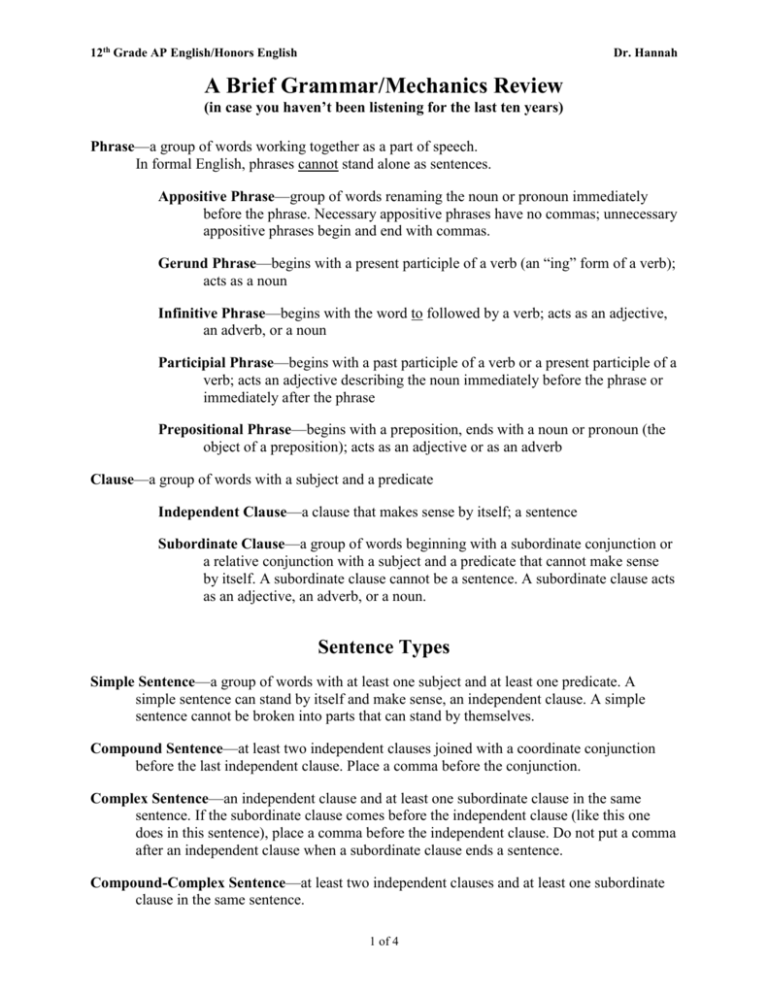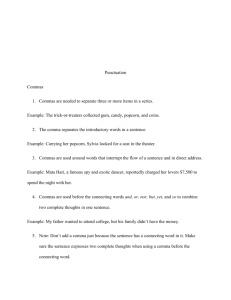Common Major Errors in Mechanics
advertisement

12th Grade AP English/Honors English Dr. Hannah A Brief Grammar/Mechanics Review (in case you haven’t been listening for the last ten years) Phrase—a group of words working together as a part of speech. In formal English, phrases cannot stand alone as sentences. Appositive Phrase—group of words renaming the noun or pronoun immediately before the phrase. Necessary appositive phrases have no commas; unnecessary appositive phrases begin and end with commas. Gerund Phrase—begins with a present participle of a verb (an “ing” form of a verb); acts as a noun Infinitive Phrase—begins with the word to followed by a verb; acts as an adjective, an adverb, or a noun Participial Phrase—begins with a past participle of a verb or a present participle of a verb; acts an adjective describing the noun immediately before the phrase or immediately after the phrase Prepositional Phrase—begins with a preposition, ends with a noun or pronoun (the object of a preposition); acts as an adjective or as an adverb Clause—a group of words with a subject and a predicate Independent Clause—a clause that makes sense by itself; a sentence Subordinate Clause—a group of words beginning with a subordinate conjunction or a relative conjunction with a subject and a predicate that cannot make sense by itself. A subordinate clause cannot be a sentence. A subordinate clause acts as an adjective, an adverb, or a noun. Sentence Types Simple Sentence—a group of words with at least one subject and at least one predicate. A simple sentence can stand by itself and make sense, an independent clause. A simple sentence cannot be broken into parts that can stand by themselves. Compound Sentence—at least two independent clauses joined with a coordinate conjunction before the last independent clause. Place a comma before the conjunction. Complex Sentence—an independent clause and at least one subordinate clause in the same sentence. If the subordinate clause comes before the independent clause (like this one does in this sentence), place a comma before the independent clause. Do not put a comma after an independent clause when a subordinate clause ends a sentence. Compound-Complex Sentence—at least two independent clauses and at least one subordinate clause in the same sentence. 1 of 4 12th Grade AP English/Honors English Dr. Hannah Punctuation Marks Apostrophe—In Modern English, we use apostrophes for two main reasons: we indicate a contraction with an apostrophe, and we show possession with an apostrophe. We RARELY use an apostrophe to make anything plural. Colon—Colons are specialized punctuation marks. Use a colon only in a place where you would normally use a period. In other words, if the wording before the colon isn’t a complete sentence, don’t use a colon. A colon can be placed between two independent clauses instead of a conjunction if you want to show that the second clause explains the first clause. MLA form also uses a colon before a quotation long enough to double-indent. Comma—Commas separate items for a reader; they do not join items. You will most often use a comma after an introductory phrase or clause, between items in a series, and before the conjunction in a compound sentence. Do not use a comma between independent clauses. Dash—Dashes are all purpose punctuation marks. In informal writing, they can be used in the place of semi-colons. They can also be used to insert a parenthetical idea into a sentence. When typing, create a dash with two hyphens without any spaces between the words or the hyphens. Ellipsis—An ellipsis is three periods with a space between each one. It indicates to the reader that the writer has omitted words from a quotation. Use an ellipsis when the reader would not be able to tell you have omitted words. Parentheses—Use parentheses with care. They are like exclamation marks in that overuse of them is annoying to a reader and interferes with your content. Avoid using parentheses to insert ideas in the middle of sentences. In most cases, using commas or dashes in these spots works better. You will most often use parentheses for internal MLA documentation. Quotation Marks—Quotation Marks indicate that the words you are writing are not your own. Do not separate the beginning quotation mark from the first letter of the quote nor the ending quotation mark from the last letter of the quote. Use double quotation marks unless you are quoting wording already containing quotation marks. In that case, replace the original quotation marks with single quotation marks while using double quotation marks to begin and end your quote. Commas and periods at the end of quotes always go inside the quotation marks. Semi-colon—Semi-colons are substitutes for conjunctions. You will most often use a semi-colon to join closely related independent clauses. Using a semi-colon is usually a stylistic choice that avoids extra words. You can also use semi-colons to separate long items containing commas in a series. 2 of 4 12th Grade AP English/Honors English Dr. Hannah Common Major Errors in Mechanics (Abbreviations I will use are in parentheses.) Run-on sentence (R-O)—A run-on sentence is a fundamental punctuation error. It occurs when the writer creates two or more independent clauses but leaves out end-punctuation such as a period or leaves out a conjunction. Whether or not a sentence is a run-on has nothing to do with its length. The determining factor is whether there are two or more independent clauses without end-punctuation or conjunctions. Comma-splice (C-S)—A comma-splice is a specific type of run-on sentence. Whether or not a sentence is a comma-splice has nothing to do with its length. A comma-splice occurs when a writer uses a comma to separate independent clauses rather than end-punctuation or conjunctions. The only way to correct a comma-splice, without rewording the sentence, is to replace the comma with end-punctuation or with a semi-colon. Removing the comma without replacing it with end-punctuation or with a semi-colon creates a runon sentence. Fragment (frag)—A fragment is an incomplete sentence. Whether or not a sentence is a fragment has nothing to do with its length. Usually a fragment occurs when a writer punctuates a phrase or a subordinate clause as a separate sentence. This mistake usually occurs when the fragment is closely related in content with the sentence before it or after it. Usually, the writer decides that the sentence he is writing is too long, and he throws in a random period, creating a fragment. Usually, you can correct a fragment by removing the period that separates the fragment from the sentence it completes. Some fragments are intentional, especially in stream of consciousness writing or in dialogue. We rarely talk in complete sentences, so fragments can add realism to dialogue. However, in formal writing, fragments are a serious error. Agreement (agr)—In formal English, certain parts of speech must stay in agreement with each other. In Old English and Middle English, agreement was required in number, case, and gender. The only part of speech that still keeps that much agreement is our pronouns. For every other part of speech, we still use agreement in number—whether words are singular or plural. We can and do break these rules when we talk, but writing, especially formal writing, demands that we keep singular with singular and plural with plural. Subject-Verb Agreement—Singular subjects require singular verbs; plural subjects require plural verbs. That idea is simple enough, but the complicating factor is that we make present tense verbs singular in Modern English by adding an “s,” a technique we associate with making nouns plural—“There’s the rub.” Pronoun-Antecedent—The antecedent of a pronoun is the word that the pronoun represents. A singular antecedent requires a singular pronoun. A plural antecedent requires a pronoun, again, simple enough. The problems usually occur when an indefinite pronoun is the antecedent. Any pronoun that ends with “one,” “body,” or “thing” is a singular pronoun. For example, “everyone” is a singular pronoun. Therefore, “Everyone left their books in the room,” is incorrect because the word their is plural, not in agreement with everyone. 3 of 4 12th Grade AP English/Honors English Dr. Hannah Another problem is the “he-or-she” monster that we create by trying not to offend anyone’s gender. Personally, I would avoid “he-or-she” as well as its cousin, “he/she.” Either use the masculine pronoun alone—the most formal rule—or reword the sentence so that the antecedents and pronouns can remain plural. Tense-shift (t-s)—A tense shift is an error that occurs when a writer changes the tense of the writing for no reason. There are legitimate reasons for changing tense in a piece of writing, but randomly jumping between past and present tenses is a major error. The writer chooses the major tense, but then the writer must stay in that tense unless there is a reason for changing. Most scholarly writing about literature is in present tense. Split infinitive (inf)—A split infinitive occurs when a writer puts a word or phrase between the word to and the verb completing the infinitive. The reason a split infinitive is considered a mistake is that splitting an infinitive is impossible in Latin. Honestly, split infinitives are becoming more accepted, but I would still avoid them in formal writing. MLA Form for Quotations (REALLY important) MLA Form for Poetry Quotations—When you quote poetry, you must punctuate and capitalize exactly as the poet has done. You must also indicate the endings of lines. After the quote, you must give the line numbers of the lines you copied in parentheses. If your quote is three lines or less, use quotation marks to begin and end the quote; use a forward slash (/) between the last word of a line and the first word of the next line. If the quotation ends at the end of a line, do not place a slash before the quotation mark. If the quotation is four lines or more, use a colon at the end of your introductory sentence. Then double indent on a new line and copy the lines of poetry EXACTLY AS THEY APPEAR IN THE TEXT. Do not add quotation marks or slashes at the ends of the lines. After giving the line numbers in parentheses, return to your original margin to continue your discussion. Do not begin a new paragraph immediately following a quotation. MLA Form for Prose Quotations—When you copy prose, the punctuation depends on the length of the quote. If the quote is less than five lines long in your paper with your margins, simply begin and end the quote with quotation marks. Place the page number(s) of the section you copied in parentheses following the quote. For prose, you do not have to show line endings so do not add slashes. If the quote is five lines or more with your margins, use a colon at the end of your introductory sentence. Then double indent on a new line and copy the prose section without adding any quotation marks. You use your own right margin since line endings are not important in prose. After giving the page number(s) in parentheses, return to your original margin to continue your discussion. Do not begin a new paragraph immediately following a quotation. 4 of 4









